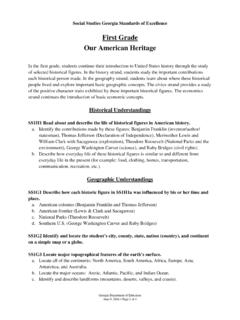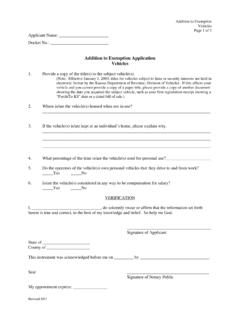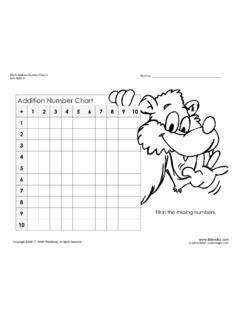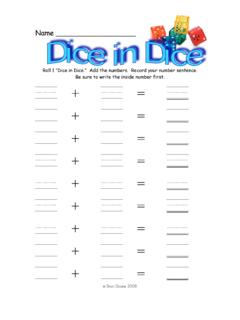Transcription of Georgia Standards of Excellence Curriculum …
1 These materials are for nonprofit educational purposes only. Any other use may constitute copyright infringement. Georgia Standards of Excellence Curriculum Frameworks GSE Third Grade Unit 1: Number and Operations in Base Ten Mathematics Georgia Department of Education Georgia Standards of Excellence Framework GSE Number and Operations in Base Ten Unit Third Grade Unit One 1 Mathematics GSE Third Grade Unit Third Grade Unit One 1: Number and Operations in Base Ten Richard Woods, State School Superintendent July 2017 Page 2 of 121 All Rights Reserved TABLE OF CONTENTS Unit Overview .. 3 Practice Standards .. 6 Content Standards .. 7 Big Ideas .. 8 Essential Questions .. 8 Concepts and Skills to Maintain .. 9 Strategies for Teaching and Learning .. 10 Selected Terms and Symbols .. 10 Tasks .. 11 Intervention Table ..16 Three Other Ways .. 18 Island Hop .. 24 Shake, Rattle, and Roll.
2 30 The Great Round Up! .. 36 Mental Mathematics .. 42 Perfect 500 .. 48 Take 1,000 .. 54 Piggy 59 Let s Think About Addition and Subtraction! .. 68 The Power of Properties .. 72 Take Down! .. 77 Happy to Eat Healthy .. 81 Field Day Fun .. 90 I Have a Story, You Have a Story .. 94 The Information Station! .. 100 It s a Data Party! .. 103 What s Your Favorite? .. 107 Cut and Plot .. 114 What s the Story Here? .. 118 IF YOU HAVE NOT READ THE THIRD GRADE Curriculum OVERVIEW IN ITS ENTIRETY PRIOR TO USE OF THIS UNIT, PLEASE STOP AND CLICK HERE: Return to the use of this unit once you ve completed reading the Curriculum Overview. Thank you. Georgia Department of Education Georgia Standards of Excellence Framework GSE Number and Operations in Base Ten Unit Third Grade Unit One 1 Mathematics GSE Third Grade Unit Third Grade Unit One 1: Number and Operations in Base Ten Richard Woods, State School Superintendent July 2017 Page 3 of 121 All Rights Reserved OVERVIEW In this unit, students will: Investigate, understand, and use place value to manipulate numbers.
3 Build on understanding of place value to round whole numbers. Continue to develop understanding of addition and subtraction and use strategies and properties to do so proficiently and fluently. Draw picture graphs with symbols that represent more than one object. Create bar graphs with intervals greater than one. Use graphs and information from data to ask questions that require students to compare quantities and use mathematical concepts and skills. Number and Prior to implementing rules for rounding, students need to have opportunities to investigate place value. A strong understanding of place value is essential for the developed number sense and the subsequent work that involves rounding numbers. Building on previous understandings of the place value of digits in multi-digit numbers, place value is used to round whole numbers. Dependence on learning rules or mnemonics can be eliminated with strategies such as the use of a number line to determine which multiple of 10 or of 100 a number is closer.
4 (5 or more rounds up, less than 5 rounds down). As students understanding of place value increases, the strategies for rounding are valuable for estimating, justifying, and predicting the reasonableness of solutions in problem-solving. Continue to use manipulatives such as hundreds charts and place-value charts. Have students use a number line or a roller coaster example to block off the numbers in different colors. For example, this chart shows which numbers will round to the tens place. Rounding can be expanded by having students identify all the numbers that will round to 30 or round to 200. Strategies used to add and subtract two-digit numbers are now applied to fluently add and subtract whole numbers within 1000. These strategies should be discussed so that students can make comparisons and move toward efficient methods. Number sense and computational understanding is built on a firm understanding of place value.
5 Georgia Department of Education Georgia Standards of Excellence Framework GSE Number and Operations in Base Ten Unit Third Grade Unit One 1 Mathematics GSE Third Grade Unit Third Grade Unit One 1: Number and Operations in Base Ten Richard Woods, State School Superintendent July 2017 Page 4 of 121 All Rights Reserved Table 1: Common Addition and Subtraction Situations Result Unknown Change Unknown Start Unknown Add to Two bunnies sat on the grass. Three more bunnies hopped there. How many bunnies are on the grass now? 2 + 3 = ? Two bunnies were sitting on the grass. Some more bunnies hopped there. Then there were five bunnies. How many bunnies hopped over to the first two? 2 + ? = 5 Some bunnies were sitting on the grass. Three more bunnies hopped there. Then there were five bunnies. How many bunnies were on the grass before? ? + 3 = 5 Take from Five apples were on the table.
6 I ate two apples. How many apples are on the table now? 5 2 = ? Five apples were on the table. I ate some apples. Then there were three apples. How many apples did I eat? 5 ? = 3 Some apples were on the table. I ate two apples. Then there were three apples. How many apples were on the table before? ? 2 = 3 Total Unknown Addend Unknown Both Addends Unknown Put together/ Take apart Three red apples and two green apples are on the table. How many apples are on the table? 3 + 2 = ? Five apples are on the table. Three are red and the rest are green. How many apples are green? 3 + ? = 5, 5 3 = ? Grandma has five flowers. How many can she put in her red vase and how many in her blue vase? 5 = 0 + 5, 5 = 5 + 0 5 = 1 + 4, 5 = 4 + 1 5 = 2 + 3, 5 = 3 + 2 Difference Unknown Bigger Unknown Smaller Unknown Compare ( How many more? version): Lucy has two apples. Julie has five apples.
7 How many more apples does Julie have than Lucy? ( How many fewer? version): Lucy has two apples. Julie has five apples. How many fewer apples does Lucy have than Julie? 2 + ? = 5, 5 2 = ? (Version with more ): Julie has three more apples than Lucy. Lucy has two apples. How many apples does Julie have? (Version with fewer ): Lucy has 3 fewer apples than Julie. Lucy has two apples. How many apples does Julie have? 2 + 3 = ?, 3 + 2 = ? (Version with more ): Julie has three more apples than Lucy. Julie has five apples. How many apples does Lucy have? (Version with fewer ): Lucy has 3 fewer apples than Julie. Julie has five apples. How many apples does Lucy have? 5 3 = ?, ? + 3 = 5 Adapted from Box 2-4 of Mathematics Learning in Early Childhood, National Research Council (2009, pp. 32,33 Georgia Department of Education Georgia Standards of Excellence Framework GSE Number and Operations in Base Ten Unit Third Grade Unit One 1 Mathematics GSE Third Grade Unit Third Grade Unit One 1: Number and Operations in Base Ten Richard Woods, State School Superintendent July 2017 Page 5 of 121 All Rights Reserved Graphing and Representation of a data set is extended from picture graphs and bar graphs with single-unit scales to scaled picture graphs and scaled bar graphs.)
8 Intervals for the graphs should relate to multiplication and division with 100 (product is 100 or less and numbers used in division are 100 or less). In picture graphs, use values for the icons in which students are having difficulty with multiplication facts. For example, represents 7 people. If there are three, students should use known facts to determine that the three icons represent 21 people. The intervals on the vertical scale in bar graphs should not exceed 100. Students are to draw picture graphs in which a symbol or picture represents more than one object. Bar graphs are drawn with intervals greater than one. Ask questions that require students to compare quantities and use mathematical concepts and skills. Use symbols on picture graphs that student can easily represent half of, or know how many half of the symbol represents. Examples of Common Graphing Situations Pose a question: Student should come up with a question.
9 What is the typical genre read in our class? Collect and organize data: student survey Pictographs: Scaled pictographs include symbols that represent multiple units. Below is an example of a pictograph with symbols that represent multiple units. Graphs should include a title, categories, category label, key, and data. How many more books did Juan read than Nancy? Number of Books Read Nancy * Juan * = 5 books Georgia Department of Education Georgia Standards of Excellence Framework GSE Number and Operations in Base Ten Unit Third Grade Unit One 1 Mathematics GSE Third Grade Unit Third Grade Unit One 1: Number and Operations in Base Ten Richard Woods, State School Superintendent July 2017 Page 6 of 121 All Rights Reserved Single Bar Graphs: Students use both horizontal and vertical bar graphs. Bar graphs include a title, scale, scale label, categories, category label, and data.
10 Analyze and Interpret data: How many more nonfiction books were read than fantasy books? Did more people read biography and mystery books or fiction and fantasy books? About how many books in all genres were read? Using the data from the graphs, what type of book was read more often than a mystery but less often than a fairytale? What interval was used for this scale? What can we say about types of books read? What is a typical type of book read? If you were to purchase a book for the class library which would be the best genre? Why? For more detailed information about unpacking the content Standards , unpacking a task, math routines and rituals, maintenance activities and more, please refer to the Grade Level Overview. Standards FOR MATHEMATICAL PRACTICE (SMP) The Standards for Mathematical Practice describe varieties of expertise that mathematics educators at all levels should seek to develop in their students.
















